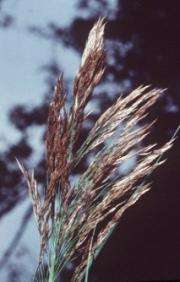Researchers map spread of invasive reed in Great Lakes basin

Phragmites australis is an uncommon term for an increasingly common sight in the wetlands and along the beaches of the Great Lakes. It’s the scientific name for the common reed, a fast-growing perennial wetland grass. An immigrant from Europe, it’s an exotic species that has a reputation for taking over any wetland real estate it visits.
Phragmites is a formidable foe. It roots easily, digs in deep and shoots runners along the ground in every direction, sprouting new plants all along the way. The reed grows tall—as high as 15 feet—and has stalks that can slice like a well-sharpened knife. It provides no food for birds and no shelter for wildlife. In fact, it threatens their very existence.
Until now, no one has done a comprehensive map showing where Phragmites is established and where it is spreading in the Great Lakes basins. The Michigan Tech Research Institute (MTRI), based in Ann Arbor, Mich., has taken on that job. To do the work, the institute has received a $580,000 federal grant from the US Fish and Wildlife Service and the US Geological Survey, funded by the US Environmental Protection Agency’s $475 million Great Lakes Restoration Initiative.
MTRI’s goal is to map the likely extent of Phragmites in each Great Lakes coastal basin—the land occupied by a lake, its shoreline and the areas near shore that drain into the lake—by 2011.
“MTRI was asked to do this work because our federal sponsors know that we are experts in using satellites to collect radar data,” said Colin Brooks, research scientist and environmental science lab manager at MTRI. Principal investigator on the research is Laura Bourgeau-Chavez, also a MTRI research scientist.
Bourgeau-Chavez, Brooks and their team are attacking the Phragmites mapping challenge two ways: high-tech and low-tech.
High-tech is MTRI’s middle name. The research center specializes in remote-sensor and information-technology development and its application to national security and infrastructure problems, as well as to earth sciences and environmental processes.
In the case of Phragmites, MTRI scientists are using Synthetic Aperture Radar (SAR), which employs satellite imagery as the primary remote sensing data source for mapping. Data from three dates during the growing season will be collected and analyzed.
“It provides unique information about wetlands,” explained Brooks. “Radar can measure the structure and biomass of wetlands, which shows us where the Phragmites areas are and how thickly they have infested an area. More traditional methods can’t do that.”
The low-tech—but equally important—aspect of the project involves deploying three field teams of two undergraduate or graduate students each out across the wetlands and along the beaches of the Great Lakes, including three Michigan Tech students. The teams are collecting samples of vegetation and measuring water conditions at nearly 400 sites throughout the Great Lakes basin.
The data MTRI collects will be combined with data from other sources including Ducks Unlimited, The Watershed Center - Grand Traverse Bay, the Michigan Department of Natural Resources and Environment and the Great Lakes Indian Fish and Wildlife Commission. The resulting database will map existing Phragmites growth and help map the potential spread of the invasive plant for each lake basin.
Provided by Michigan Technological University













